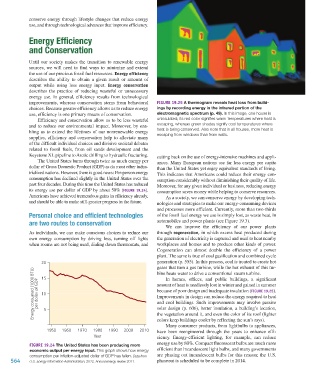Page 565 - Environment: The Science Behind the Stories
P. 565
conserve energy through lifestyle changes that reduce energy
use, and through technological advances that improve efficiency.
Energy Efficiency
and Conservation
Until our society makes the transition to renewable energy
sources, we will need to find ways to minimize and extend
the use of our precious fossil fuel resources. Energy efficiency
describes the ability to obtain a given result or amount of
output while using less energy input. Energy conservation
describes the practice of reducing wasteful or unnecessary
energy use. In general, efficiency results from technological
improvements, whereas conservation stems from behavioral FIGURE 19.25 A thermogram reveals heat loss from build-
choices. Because greater efficiency allows us to reduce energy ings by recording energy in the infrared portion of the
use, efficiency is one primary means of conservation. electromagnetic spectrum (p. 49). In this image, one house is
Efficiency and conservation allow us to be less wasteful uninsulated; its red color signifies warm temperatures where heat is
and to reduce our environmental impact. Moreover, by ena- escaping, whereas green shades signify cool temperatures where
bling us to extend the lifetimes of our nonrenewable energy heat is being conserved. Also note that in all houses, more heat is
escaping from windows than from walls.
supplies, efficiency and conservation help to alleviate many
of the difficult individual choices and divisive societal debates
related to fossil fuels, from oil sands development and the
Keystone XL pipeline to Arctic drilling to hydraulic fracturing. cutting back on the use of energy-intensive machines and appli-
The United States burns through twice as much energy per ances. Many European nations use far less energy per capita
dollar of Gross Domestic Product (GDP) as do most other indus- than the United States yet enjoy equivalent standards of living.
trialized nations. However, there is good news: Per-person energy This indicates that Americans could reduce their energy con-
consumption has declined slightly in the United States over the sumption considerably without diminishing their quality of life.
past four decades. During this time the United States has reduced Moreover, for any given individual or business, reducing energy
its energy use per dollar of GDP by about 50% (FIGURE 19.24). consumption saves money while helping to conserve resources.
Americans have achieved tremendous gains in efficiency already, As a society, we can conserve energy by developing tech-
and should be able to make still-greater progress in the future. nologies and strategies to make our energy-consuming devices
and processes more efficient. Currently, more than two-thirds
Personal choice and efficient technologies of the fossil fuel energy we use is simply lost, as waste heat, in
are two routes to conservation automobiles and power plants (see Figure 19.3).
We can improve the efficiency of our power plants
As individuals, we can make conscious choices to reduce our through cogeneration, in which excess heat produced during
own energy consumption by driving less, turning off lights the generation of electricity is captured and used to heat nearby
when rooms are not being used, dialing down thermostats, and workplaces and homes and to produce other kinds of power.
Cogeneration can almost double the efficiency of a power
plant. The same is true of coal gasification and combined cycle
20 generation (p. 555). In this process, coal is treated to create hot
gases that turn a gas turbine, while the hot exhaust of this tur-
Energy consumed (1000 BTU) per dollar of GDP 10 amount of heat is needlessly lost in winter and gained in summer
bine heats water to drive a conventional steam turbine.
15
In homes, offices, and public buildings, a significant
because of poor design and inadequate insulation (FIGURE 19.25).
Improvements in design can reduce the energy required to heat
and cool buildings. Such improvements may involve passive
solar design (p. 606), better insulation, a building’s location,
5
the vegetation around it, and even the color of its roof (lighter
colors keep buildings cooler by reflecting the sun’s rays).
Many consumer products, from lightbulbs to appliances,
1950 1960 1970 1980 1990 2000 2010 have been reengineered through the years to enhance effi-
Year ciency. Energy-efficient lighting, for example, can reduce
FIGURE 19.24 The United States has been producing more energy use by 80%. Compact fluorescent bulbs are much more
economic output per energy input. This graph shows how energy efficient than incandescent light bulbs, and many governments
consumption per inflation-adjusted dollar of GDP has fallen. Data from are phasing out incandescent bulbs for this reason; the U.S.
564 U.S. Energy Information Administration, 2012. Annual energy review 2011. phaseout is scheduled to be complete in 2014.
M19_WITH7428_05_SE_C19.indd 564 12/12/14 5:23 PM

